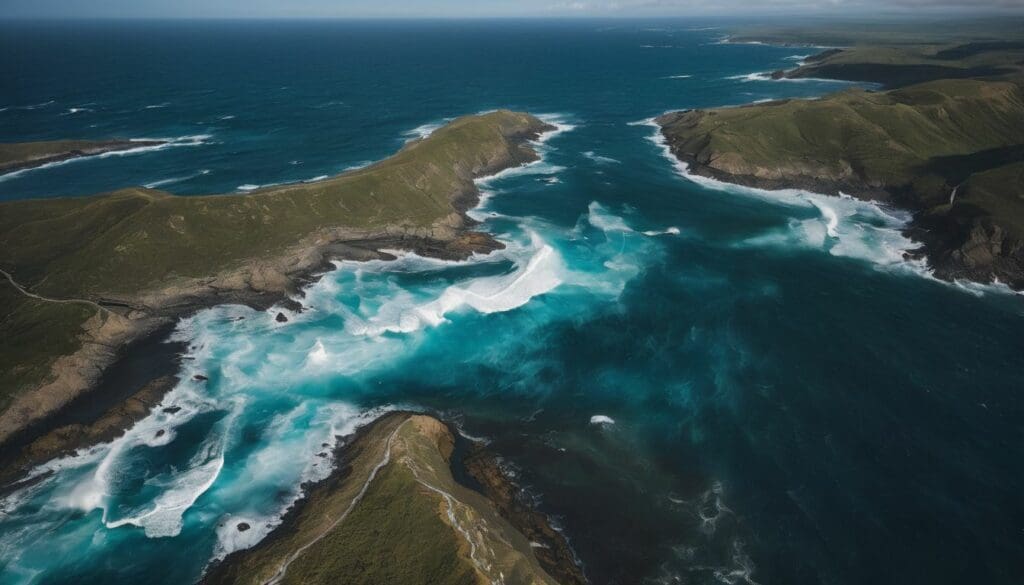Our oceans are changing, and it’s affecting life above and below the waves. Ocean currents, these vast underwater rivers, play a crucial role in shaping our planet’s climate. This blog post will explore how climate change is destabilising these vital patterns and what that means for all of us.
Dive in to understand why this matters.
Key Takeaways
- Ocean currents act like conveyor belts, moving warm and cold water around the globe, which helps to regulate our climate by controlling temperature and weather patterns.
- Climate change is causing ocean temperatures to rise, glaciers and sea ice to melt, and altering the salinity of seawater – all factors that can weaken ocean currents and impact global weather systems.
- Rising ocean temperatures and increased acidification from higher CO2 levels are harming marine ecosystems, including coral reefs and fish populations that many coastal communities depend on for food and livelihood.
- The melting of polar ice as a result of warming oceans is contributing to rising sea levels, threatening coastal habitats with erosion and flooding.
- To preserve stable weather patterns, strong ocean currents are essential; therefore tackling climate change is critical for maintaining these currents’ vital role in sustaining planetary health.
Understanding Ocean Currents
Ocean currents are continuous, directed movements of ocean water that play a crucial role in regulating global climate and weather patterns. They transport heat and moisture around the world, influencing temperatures and precipitation.
What are they?
Ocean currents are rivers of seawater flowing through our planet’s vast oceans. They act as conveyor belts, transporting warm water and precipitation from the equator towards the poles, while carrying colder water back towards the equator.
Governed by wind patterns, the rotation of the Earth, and differences in water density, these currents have a major role in stabilising global climate. Their influence extends beyond temperature regulation; they affect weather systems and play a crucial part in sustaining marine life.
Currents vary in size and speed: some are enormous flows spanning thousands of miles; others are narrower streams within the sea. Thermohaline circulation is one such deep-water process driven by variations in temperature (thermal) and saltiness (haline).
This circulation plays an essential part in distributing heat around our globe which affects regional climates. Together with wind-driven movement at the ocean’s surface, these forces combine to form a complex system impacting everything from global warming trends to marine biodiversity health.
How do they affect climate and weather?
Ocean currents play a crucial role in shaping the climate and weather patterns around the world. They distribute heat and moisture, influencing weather systems and regulating global climate.
Additionally, ocean currents impact temperature variations, affecting marine ecosystems and coastal areas.
As a result of their continuous movement, ocean currents have a significant influence on weather patterns. They help in distributing heat across the globe, impacting regional climates.
The Impact of Climate Change
The impact of climate change on ocean currents is evident in the increasing ocean temperatures, melting of glaciers and sea ice, and changes in ocean salinity. These changes have severe consequences on marine ecosystems and global climate patterns.
Increase in ocean temperatures
Ocean temperatures are rising due to climate change, impacting marine life and ecosystems. This increase is caused by the absorption of excess greenhouse gases in the atmosphere. It leads to changes in ocean currents, which affects weather patterns and disrupts vital marine habitats.
The warming waters also contribute to the melting of polar ice caps, influencing sea levels and threatening coastal areas with erosion.
The rise in ocean temperatures causes stress on marine species and coral reefs, impacting their survival and reproduction. Additionally, it alters fish migration patterns affecting global fisheries.
Melting of glaciers and sea ice
The melting of glaciers and sea ice is contributing to the rise in sea levels, posing a threat to coastal areas and marine habitats. As these frozen water sources melt due to global warming, they release freshwater into the ocean, impacting the salinity levels and disrupting ocean currents.
This influx of freshwater can weaken the thermohaline circulation, affecting the distribution of heat and moisture around the globe.
Additionally, the melting of glaciers and sea ice contributes to an increase in ocean temperatures which can have devastating effects on marine biodiversity. The loss of critical habitat for polar species further signifies the far-reaching consequences of this phenomenon on our planet’s delicate ecosystems.
Changes in ocean salinity
As global temperatures rise, the melting of glaciers and increased evaporation drive changes in ocean salinity. The influx of freshwater from melting polar ice caps can disrupt the delicate balance of salt and water in the oceans, impacting marine life and altering ocean currents.
This shift in salinity levels can have far-reaching effects on weather patterns, marine ecosystems, and the regulation of global climate.
The changing ocean salinity due to global warming highlights the complex interplay between environmental factors and their impact on our planet’s delicate systems. These alterations in salt content not only affect marine life but also contribute to shifts in weather patterns and ocean circulation that influence our planet’s climate.
Understanding these changes is crucial for developing strategies to mitigate the impact of climate change on our oceans.
Consequences of Weakened Ocean Currents
The weakening of ocean currents can lead to a disruption of marine ecosystems, an increase in ocean acidification, and have widespread effects on global climate. These consequences highlight the importance of maintaining strong and healthy ocean currents for the wellbeing of our planet.
Disruption of marine ecosystems
Rising ocean temperatures, caused by climate change, are disrupting marine ecosystems. This increase in temperature is altering the distribution and behavior of marine species, impacting their breeding patterns and food sources.
Additionally, ocean acidification due to higher levels of carbon dioxide in the water is affecting the growth and survival of various marine organisms such as corals, shellfish, and plankton.
Furthermore, the weakening of ocean currents may lead to changes in nutrient availability in different regions of the oceans. This can affect primary productivity and ultimately impact higher trophic levels within marine food webs.
Increasing ocean acidification
Ocean acidification is a direct result of rising levels of carbon dioxide in the atmosphere. This CO2 dissolves into oceans, forming carbonic acid, which lowers the pH of seawater and poses a threat to marine life.
As ocean acidity rises, it impacts the ability of certain organisms to build their calcium carbonate shells or skeletons, imperiling vital ocean ecosystems.
The escalating levels of ocean acidification pose a significant risk to marine biodiversity by undermining the health and resilience of coral reefs and shellfish populations. This could lead to detrimental consequences for fisheries and coastal protection from storms.
Understanding these threats underscores why it’s crucial to address climate change effectively while also safeguarding our planet’s delicate ecosystems.
Effects on global climate
The increase in ocean temperatures due to climate change alters weather patterns and affects global climate. This disrupts the distribution of heat and moisture, leading to extreme weather events and changes in precipitation patterns globally.
As a result, marine ecosystems are impacted, causing shifts in fish populations and altering food chains.
The weakening of crucial ocean current systems further accelerates global warming by disrupting the transport of heat across the planet’s surface. The collapse of these vital conveyer belts also contributes to rising sea levels, coastal erosion, and polar ice melting, intensifying the impacts of climate change on a global scale.
The Role of Ocean Currents in Regulating Climate
Ocean currents play a crucial role in distributing heat and moisture around the globe, influencing weather systems and maintaining global climate stability. To learn more about the impact of climate change on ocean currents, continue reading.
Distribution of heat and moisture
Ocean currents play a crucial role in distributing heat and moisture around the globe. Warm ocean currents transport heat from the equator towards the poles, influencing regional climates and weather patterns.
Conversely, cold ocean currents bring cool temperatures to warmer regions, affecting local climates and ecosystems. Additionally, these currents also distribute moisture across different regions, influencing rainfall patterns and contributing to the Earth’s water cycle.
The distribution of heat and moisture by ocean currents impacts not only marine life but also terrestrial environments. As warm water moves towards higher latitudes, it releases heat into the atmosphere, affecting nearby land areas.
Influence on weather systems
Ocean currents play a crucial role in influencing weather systems around the world. These currents distribute heat and moisture, affecting atmospheric conditions and climates in various regions.
The speed and direction of ocean currents impact wind patterns, which directly influence local weather systems. Changes in ocean currents due to climate change can lead to alterations in weather patterns, such as shifts in rainfall distribution or the frequency of extreme weather events like hurricanes and cyclones.
It is essential to recognise the significant influence that ocean currents have on shaping our planet’s weather systems and understand the potential impacts of climate change on these vital processes.
The movement of ocean currents affects atmospheric circulation, leading to changes in precipitation patterns and temperature distributions across different areas. As global temperatures rise due to climate change, alterations in ocean current strength could result in more unpredictable and severe weather phenomena worldwide.
Importance of maintaining strong currents
Maintaining strong ocean currents is crucial for regulating climate and weather patterns. These currents distribute heat and moisture across the globe, influencing weather systems and ensuring stable climate conditions.
The speed and strength of these currents play a pivotal role in supporting marine ecosystems, as well as mitigating ocean acidification by facilitating the transport of nutrients and carbon dioxide.
Furthermore, strong ocean currents help to regulate sea surface temperatures, which directly impacts marine biodiversity. Additionally, they play a significant role in moderating global climate by transporting warm water from the equator to higher latitudes.
Conclusion
In conclusion, climate change is impacting ocean currents by increasing temperatures and melting glaciers. Weakening currents disrupt marine ecosystems and contribute to ocean acidification.
The regulation of heat and moisture by these currents is crucial for maintaining a stable global climate. It’s essential to address the impact of climate change on ocean currents for the health of our planet.
FAQs
1. What happens to ocean currents because of climate change?
Climate change can disrupt the global conveyor belt, weaken ocean circulation, and influence thermohaline circulation due to effects like glacial melting and freshwater influx.
2. How does global warming affect marine life in the oceans?
The impact of global warming on ocean currents alters temperature and salt levels which affects marine biodiversity, potentially leading to ecosystem damage.
3. Will sea level rise as a result of changes in ocean currents?
Yes, disruptions in ocean currents from climate change can contribute to sea level rise alongside other factors like glacial melting.
4. Do faster-moving ocean currents due to global warming influence our weather?
Indeed, speeding up of ocean currents may significantly impact weather patterns around the world since they play a crucial role in distributing heat across the globe.
5. Is there a risk that crucial ocean current systems could collapse because of climate change?
There’s concern among scientists that continued effects of climate change might lead to the collapse or significant weakening of crucial current systems which are vital for maintaining Earth’s climate stability.





